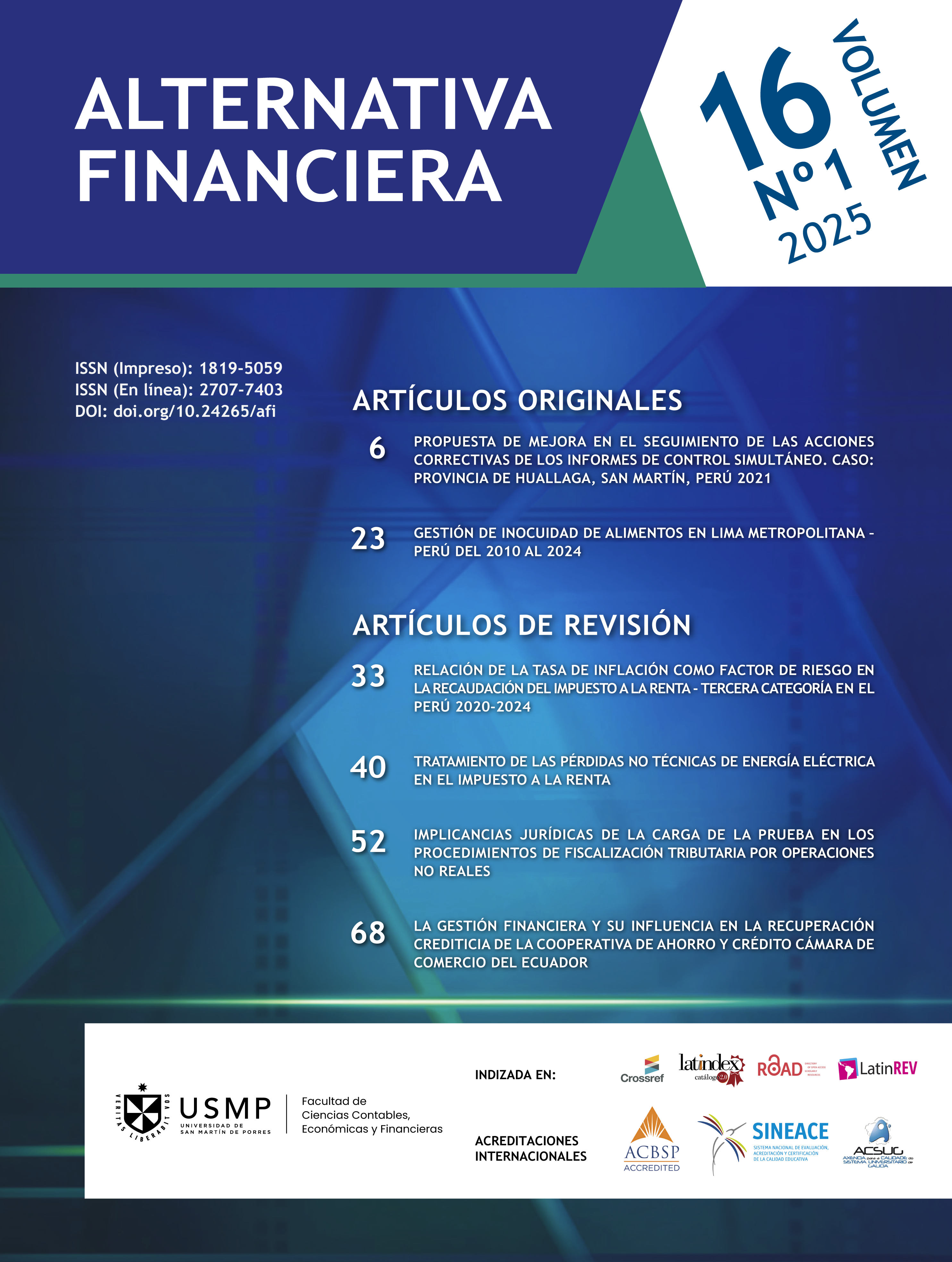FOOD SAFETY MANAGEMENT IN METROPOLITAN LIMA, PERU, FROM 2010 TO 2024
DOI:
https://doi.org/10.24265/afi.2025.v16n1.02Keywords:
inocuidad de alimentos, ETA, salud pública, DIGESA, SENASA, SANIPES, calidadAbstract
The objective of this study was to evaluate the influence of the integration of management processes among different sanitary authorities on food safety in Lima, during the period 2010–2024. Surveys were conducted with a sample of 90 public officials, divided among DIGESA, SENASA, and SANIPES, representing three sanitary authorities. The findings indicate that food safety management is insufficient, mainly due to poor risk assessment by the public sector and inadequate implementation of existing regulations. A lack of appropriate allocation of financial and human resources to the sanitary authorities was identified, along with limited consumer awareness regarding the importance of food safety. These factors have led to the ineffective implementation of a food safety management system. Among the most notable findings, only 4% of food manufacturing establishments possess all required sanitary authorizations. Pesticide levels in fruit and vegetable products reach 29.5%, while in meat products they reach 10%. The prevalence of heavy metals in fruit and vegetable products is 18%, and 10% in meat products. An average of 10 cases of Foodborne Diseases (FBD) per year has been reported over the past 14 years. These findings highlight significant shortcomings in the surveillance and monitoring of food safety by sanitary authorities.
Keywords: food safety, FBD, public health, DIGESA, SENASA, SANIPES, quality.
Downloads
References
Chu, M. (2014). The internationalisation of regulation: Food safety regulation in China [Tesis doctoral, The London School of Economics and Political Science].
Fonseca, M. C. P. (2009). Os riscos e perigos dos alimentos na percepção dos consumidores: Food risks and hazards according to consumers perception.
Galiani, S. (2006). Políticas sociales: Instituciones, información y conocimiento (LC/L.2482-P). Comisión Económica para América Latina y el Caribe (CEPAL).
García, M., Fearne, A., Caswell, J., & Henson, S. (2007). Co-regulation as a possible model for food safety governance: Opportunities for public-private partnerships. Food Policy, 32(3), 299–314. https://doi.org/10.1016/j.foodpol.2006.07.006
Hernández, R., Fernández, C., & Baptista, P. (2003). Metodología de la investigación (5.ª ed.). McGraw-Hill.
Horton, D., Alexaki, A., Bennett-Lartey, S., et al. (2010). Evaluating capacity development: Experiences from research and development organizations around the world. International Service for National Agricultural Research; International Development Research Centre; ACP-EU Technical Centre for Agricultural and Rural Cooperation. http://www.isnar.cgiar.org/ecd/publications.htm
Macera, J., & Tácunan, M. (2014). Comida ambulante: Ofertas gastronómicas de Lima Norte.
Mizrahi, Y. (2004). Capacity enhancement indicators: Review of the literature (World Bank Institute Working Paper). Instituto del Banco Mundial. https://siteresources.worldbank.org/WBI/Resources/wbi37232Mizrahi.pdf
Morgan, P. (2007). The design and use of capacity development indicators. Canadian International Development Agency (CIDA). https://www.oecd.org/dataoecd/34/37/1919953.pdf
Organización para la Alimentación y la Agricultura - FAO /Organización Mundial de la Salud - OMS. (1997). Informe de la consulta mixta FAO/OMS sobre gestión de riesgos e inocuidad de los alimentos (WHO/FNU/FOS/97.8). Organización de las Naciones Unidas para la Agricultura y la Alimentación.
Organización para la Alimentación y la Agricultura - FAO. (2007). Fortalecimiento de los sistemas nacionales de control de los alimentos: Directrices para evaluar las necesidades de fortalecimiento de la capacidad. Dirección de Nutrición y Protección del Consumidor, Organización de las Naciones Unidas para la Agricultura y la Alimentación.
Organización para la Alimentación y la Agricultura - FAO. (2010). Taller de coordinación proyecto TCP/RLA/3213: Asistencia para el diseño y/o fortalecimiento de políticas de inocuidad de alimentos para los países de la región. https://www.rlc.fao.org/es/inocuidad/noticias.htm
Organización para la Alimentación y la Agricultura - FAO /Organización Mundial de la Salud - OMS. (2010). Garantía de la inocuidad y calidad de los alimentos: Directrices para el fortalecimiento de los sistemas nacionales de control de los alimentos (Estudio FAO Alimentación y Nutrición No. 76). Organización de las Naciones Unidas para la Agricultura y la Alimentación. https://ftp.fao.org/docrep/fao/006/y8705s/y8705s00.pdf
Organización para la Alimentación y la Agricultura - FAO. (2002). Informe de la Cumbre Mundial sobre la Alimentación: Cinco años después. FAO. https://ftp.fao.org/docrep/fao../Meeting/005/y7106s.pdf
Programa de las Naciones Unidas para el Desarrollo (PNUD). (2018). Capacity assessment and development in a systems and strategic management context (Technical Advisory Paper No. 3). https://magnet.undp.org/docs/cap/CAPTECH3.htm
U.S. Food and Drug Administration (FDA). (2010). Informes de rechazos a importaciones del Sistema Administrativo y Operacional de Apoyo a las Importaciones (OASIS). https://www.fda.gov/ora/oasis/ora_oasis_ref.html
Downloads
Published
Issue
Section
License
Copyright (c) 2025 Paola Fano Castro

This work is licensed under a Creative Commons Attribution-NonCommercial-ShareAlike 4.0 International License.
Creative Commons Atribución-NoComercial-CompartirIgual 4.0 Internacional (CC BY-NC-SA 4.0). Faculta a los usuarios a compartir: copiar y redistribuir el material en cualquier medio o formato y adaptar: remezclar, transformar y desarrollar el material, siempre y cuando se acredite al autor original, no se utilice con propósitos comerciales y las nuevas creaciones se licencien bajo los mismos términos de esta licencia.













